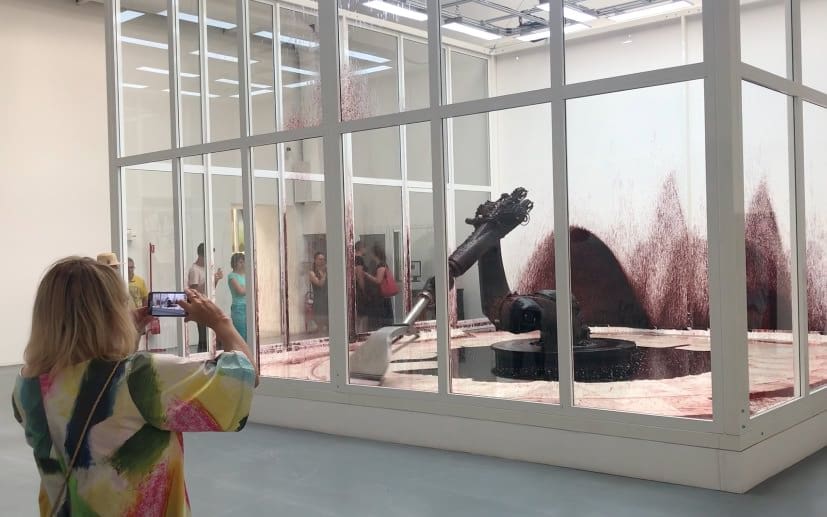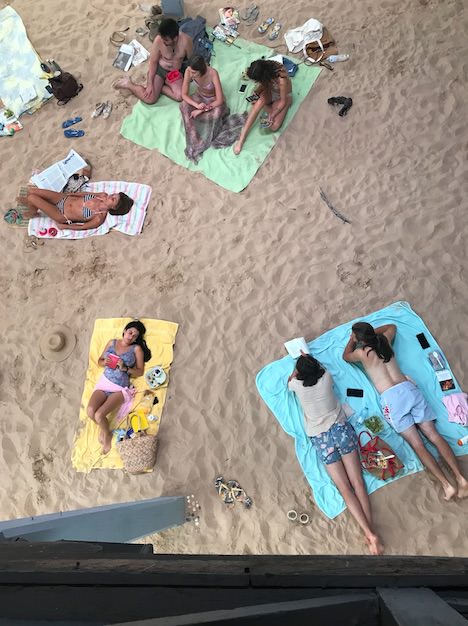This edition of Venice Biennale is called May You Live in Interesting Times. And indeed, we do. From the climate crisis to the rise of artificial intelligence systems, how we define ourselves and how we relate to the external world is shifting. How will we adapt to these new paradigms? Do performance, live arts, and shared experiences help us approach these questions in a radically changing world?
Sun & Sea (Marina) won the Golden Lion at Venice Biennale. In this piece, the audience peers down over a railing to see a beach inside of a large space. The performers go about mundane beach holiday activities, while singing songs about work, boredom, and personal life. Undercurrents of eco-anxiety and looming environmental crisis leak into these topics. A mother sings about how her eight-year-old has already visited most of the seas in the world; an older professional complains about how he can’t slow down at work because his colleagues would look down on him; a chorus announces that the red flag is up at the beach; a young woman sings about how her eyelids are heavy and that there’s no water left in her bottle. The jury’s statement describes the piece as “a critique of leisure and of our times” and praises “the Pavilion’s engagement with the city of Venice and its inhabitants”. Sun & Sea creates a space for reflection for the travelling art lovers of the world.
Sun Yuan and Peng Yu’s Can’t Help Myself offers one of the most memorable performances in the Biennale; a performance not by a human but by a machine. An industrial robot, displayed behind a glass cage like a captured animal, moves restlessly as it tries to keep oozing blood contained in a particular area. The artists also taught the robot a few other movements such as “scratch an itch” or “ass shake”. Between its duty of collecting blood, the robot performs elegant moves, that uncannily renders it as a living creature. Can’t Help Myself might be the most emotionally accessible performance that I’ve encountered performed by a robot.
 A graceful machine
A graceful machine
Speaking of non-human performances, Ed Atkins’ work also presents an interesting angle. In his videos, 3D characters look at the virtual camera right in the eye and cry their eyes out. This encounter with a CGI character presenting the most vulnerable human affections creates an ambiguity that’s hard to navigate––what is the audience supposed to feel? How does one react to a perfectly simulated vulnerability, knowing that it’s not real?
 How to console a sad simulation?
How to console a sad simulation?
Another video among Ed Atkins’ work uses crowd simulation. Crowd simulations are built with physics engines which can simulate certain phenomena, such as a wave in an ocean, or a glass dropping to a concrete floor, or the behavior of human crowds. In this piece, hundreds of people run towards a central point where an invisible explosion happens and scatters everybody away. There’s a dark grandeur to this piece. Similar to this piece, other artists create work that entail crowd simulations––such as Ars Electronica festival prize-winners Kids and Emergence. In Emergence, the user control a prophet-like man, whose movement controls how hundreds of people around him act. In Kids, by pressing on the screen, the user can make hundreds of human looking characters fall into a pitless hole. The crowd simulation form seems like a new existentialist art form for this new age. It acts as a metaphor of what we already experience and what we fear is coming––it’s the dark shared experience that we don’t want but we’re left with.
 A crowd running towards their predetermined destination
A crowd running towards their predetermined destination
There are a few other works that create speculative spaces for shared experience. The Philippine Pavilion presents a contemporary trompe l’oeil––visitors step on clear platforms and when they look down, see an endless pit beneath the glass floor. This piece is experienced by multiple people at the same time, and it creates a shared experience of walking on top of the void, together.
Another interesting piece is Ryoji Ikeda’s spectra III. In order to leave the main exhibition, visitors need to walk through an extremely bright corridor, illuminated by very strong LED lights. This is disorienting, when viewers leave the corridor they need to re-adjust to the new light levels together before they can move on. Both these pieces offer chances for unexpected shared experiences.
 A visitor trying to avoid the painful brightness of Spectra III
A visitor trying to avoid the painful brightness of Spectra III
Hito Steyerl’s video This Is the Future delves into how AI prediction creates and imposes a future that is based on the data of the past. A predictable future is not only oppressive but also bleak. These works in the Biennale offer something unpredictable, that is capable of making us live not in a determined future’s past.
Written by Deniz Tortum


